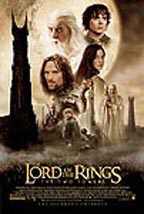It is difficult to argue against the popularity of The Lord of the Rings: The Two Towers. Although stripped of most of the book’s multi-cultural layering, the film manages to capture the power and violence of the books in ways few previous efforts have.
Two Towers is the second in a series of three films that attempts the monumental task of translating the most popular fantasy in history to the screen. While filmmaker Peter Jackson is hardly as scrupulous in converting the novel to film as many critics claim, his presentation goes a long way to presenting an extremely complex fantasy world to the general public. As in the first film in the series Fellowship of the Ring, Jackson continued to introduce the public to unfamiliar fantasy characters such as hobbits, ents, orcs and wargs as everyday people and introduced variations on classic fairy tale characters such as elves, dwarves and trolls. This film, too, managed to pick up where the first film left off without needing to provide an explanation explain to the audience – except through a series of film clips. The audience gets dumped into the middle of an action sequence that hardly slackens until the end of the film. Since this is the middle film in the series that will conclude with Return of the King due for release next December, Jackson manages to satisfy audience expectations for a resolution without taking away from the anticipation of what the final film will bring. Three films encompass a tale of good versus evil in which forces for good have stumbled into possession of evil’s most powerful weapon: the ring of power. The three volumes depict the efforts of the good forces to destroy the ring and avoid the temptation of using it as a weapon for their own side.
Jackson’s dedication to the original books, however, is grossly overrated. As in plays written by Shakespeare, interpretations of the books’ author J.R.R. Tolkien provides a relatively easy roadmap for translation to film -provided you stick to his scripting. The first two Jackson films largely succeed when they follow the original tale and fail where they do not, with one important exception.
In shifting some of the structure of the films that shifts focus between two sets of heroes, Jackson’s films maintains tension as well as clarity of time the original books lacked. The film flashes back and forth between two vital conflicts that of the film’s principle warrior Aragorn (played by Viggo Mortensen) in his effort to rescue two hobbits kidnapped at the end of the previous film. This inevitably leads to a massive battle of armies as evil forces lay siege to a fortress defended by forces for good. Jackson’s film frequently flashes back to the second important thread begun at the end of the first film in which the hobbits, Frodo (Elijah Wood) and Sam (Sean Astin) struggle to find a path to the volcano into which they must throw the ring.
Jackson, however, takes other liberties with the original tale that work less well or not at all, simplifying sections so as not to confuse readers in some cases, while in other cases he even adds scenes not in the original tale. The vanishing of Aragorn wastes valuable time, as does the extraneous misguided kidnapping of Frodo by another of the film’s heroes, gutting one of the most meaningful and moving scenes in the books. Jackson also strips the film of all but a passing reference to music or poetry, huge elements used in the books to define various cultures. For these aspects, avid fans will have to seek out the books.
More disturbing was the more subtle shift in philosophy, giving Two Towers a pro-war philosophy when Tolkien emphasized a more spiritual one. Throughout Two Towers, Jackson expounds on the need for heroes to fight against evil, when Tolkien – shocked by the horrors of World War I in which he fought – emphasized the need for self-sacrifice.
Jackson’s greatest success in Two Towers, however, was in his ability to bring to the screen one of literature’s greatest characters and thus producing what will likely become an Oscar-winning performance.
Gollum (sometimes called Sméagol) is a hobbit-like creature perverted to evil by long possession of the evil ring. The book and film use this character to show how fair treatment and faith can restore even the vilest of creatures, while mistrust can drive such a character into doing foul deeds.
Gollum (played by actor Andy Serkis and altered by animation) steals the show and viewers’ hearts in a way few roles have since Trainman. This twisted character evokes disgust as well as sympathy, and Serkis’ performance is so moving that you can feel his pain and experience his madness, as two sides of his character struggle with the choice between doing good or falling back into evil ways.
For this performance alone, I recommend Two Towers. Despite the film’s deviations from the original story, Two Towers, with its hours of battle scenes, is among the best action flicks of the season, and perhaps one of the most visually compelling.
New Line Cinema’s The Lord of the Rings: The Two Towers is two hours and 59 minutes. It’s rated PG-13 for its epic battle sequences and scary images. The film is currently playing at theaters nationwide. q
